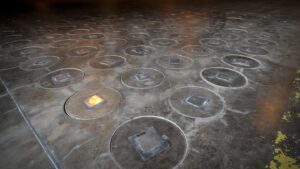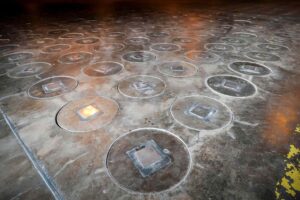Radioactive Wasp Nest Discovered in South Carolina: Savannah River Site Update
💥 Radioactive Wasp Nest Found at Former U.S. Nuclear Site — Here’s What Really Happened
URL Slug: /radioactive-wasp-nest-savannah-river-site
Meta Title: Radioactive Wasp Nest Discovered in South Carolina: Savannah River Site Update
Meta Description: A wasp nest with dangerous radiation levels was found at the Savannah River Site, a former nuclear weapons plant. Here’s what caused it and why you shouldn’t panic.
Focus Keyword: radioactive wasp nest
Related Keywords: Savannah River Site radioactive news, nuclear contamination wasp nest, radioactive insects South Carolina, radioactive wildlife
📍 A Tiny Nest With a Big Scare
Imagine this: you’re a worker walking past a rusty metal post near a decades-old nuclear waste site. You spot a seemingly harmless, abandoned wasp nest. But when you scan it with a Geiger counter, the alarm screams.

That’s exactly what happened in July 2025 at the Savannah River Site in South Carolina, a former U.S. nuclear weapons facility that once helped build the atomic bomb. The wasp nest? It was radioactive.
Not “mildly concerning” radioactive — we’re talking 10 times over the legal safety threshold.
🧪 What Was Found?
-
📆 Date Discovered: July 3, 2025
-
📍 Location: A metal post (called a stanchion) near underground radioactive waste tanks
-
☢️ Radiation Level: Over 100,000 disintegrations per minute — that’s 10x the federal contamination limit
-
🧹 Action Taken: Wasps eliminated, nest removed and bagged as radioactive waste
This wasn’t an active nest. No glowing insects. No superwasps. Just a leftover structure that happened to soak up radiation from its surroundings.
🤔 Why Was the Nest Radioactive?
Wasps, especially mud daubers, use soil and plant fibers to build their nests. If the soil they collect from is contaminated, the nest becomes contaminated too.
According to environmental experts, the Savannah River Site still has residual radiation in certain areas, especially near aging waste storage units from the Cold War.
So when these wasps gathered dirt and mud from those spots, they unknowingly built a radioactive home.
“This doesn’t mean the wasps were radioactive. But their construction materials definitely were.”
— U.S. Department of Energy spokesperson
😱 Should You Be Worried?
Let’s get one thing straight:
🛑 This was NOT a leak
🛑 This was NOT a threat to the public
🛑 No one was harmed
The wasp nest was found inside a secure, fenced-off industrial zone. Radiation workers discovered it during routine safety scans, acted fast, and removed it without incident.
Still, the very idea of a radioactive insect nest makes your skin crawl, doesn’t it?

🧠 The Science Behind the Scare
Here’s how this happened:
-
Wasps built a nest on a metal post near a buried waste tank
-
The mud they used contained radioactive particles
-
The nest absorbed and held those radioactive elements
-
Once the wasps left, the abandoned nest remained dangerous
It’s kind of like making a house out of asbestos without knowing. The material is the problem — not the builder.
🔄 Has This Happened Before?
Yes — and not just once.
🐝 Hanford Nuclear Site (Washington, 2003)
At Hanford — another U.S. nuclear cleanup site — thousands of mud-dauber nests were found radioactive in recently cleaned soil areas. The cleanup crew had to dig up the soil all over again.
Wildlife like wasps, rodents, and birds don’t know they’re entering radioactive zones. Their activities create new pathways for contamination, even in areas where humans think the risk is gone.
👷 How Was It Cleaned Up?
The Savannah River Site team followed standard nuclear safety protocol:
-
🐝 Sprayed and neutralized any remaining insects
-
🧪 Tested the nest for contamination level
-
🧤 Carefully removed the nest and surrounding dust
-
🧼 Decontaminated the area with high-pressure tools
-
🗑️ Sealed and stored the nest as low-level radioactive waste
“It’s gone. It’s sealed. And it never left the site,”
— On-site DOE engineer
📜 A Quick Look at Savannah River Site (SRS)
-
Operated from the 1950s to produce plutonium and tritium for U.S. nuclear bombs
-
Covers over 300 square miles
-
Home to aging waste tanks, many of which are being decommissioned
-
Currently under federal cleanup involving billions of dollars
It’s one of the largest environmental remediation projects in the world. But clearly, even nature can throw curveballs.
🌱 Nature Finds a Way — Even in Radiation
Animals and insects don’t obey fences. They dig, crawl, and fly wherever they want. And in doing so, they can unintentionally uncover or spread hidden contamination.
It’s why modern nuclear sites are now investing in wildlife monitoring as part of their safety plan.
🧭 What Happens Now?
The U.S. Department of Energy has:
-
Launched a full investigation
-
Issued alerts for increased wasp nest monitoring
-
Started a deeper soil scan in the surrounding area
-
Reassured that the radiation was localized and contained
Environmental groups are asking for transparency and even broader public reporting of site scans, including wildlife incidents.
💬 Expert Opinions
“This is a cautionary tale about the persistence of contamination — and the ingenuity of insects.”
— Dr. Helen Carter, Environmental Biologist
“There’s no cause for public panic. But there is cause for better ecological oversight in nuclear cleanup zones.”
— Tom Clements, Savannah River Site Watch
🔍 FAQs
Q: Was the nest leaking radiation into the air?
No. Radiation doesn’t “leak” from nests. The particles were fixed in the mud, and the site was already restricted.
Q: Could radioactive wasps fly into neighborhoods?
Highly unlikely. Most wasps stay close to their nest — usually under 500 meters. And this nest was found far inside a controlled area.
Q: Are more nests expected to be radioactive?
Possibly. That’s why the DOE is increasing inspections, especially in older zones with known soil contamination.
📌 TL;DR Summary
| 🔍 Topic | ✅ Details |
|---|---|
| What | A radioactive wasp nest was found |
| Where | Savannah River Site, South Carolina |
| When | July 3, 2025 |
| How | Wasps used contaminated mud near a waste tank |
| Radiation Level | 10x higher than federal safety limit |
| Is the public at risk? | No — the site is secure and the nest removed |
| Why it matters | Shows how nature interacts with toxic legacy sites |
💡 Final Thoughts: A Reminder From Mother Nature
Sometimes, the most unexpected things teach us the biggest lessons. A small wasp nest has reminded the world that even decades after nuclear activity ends, nature can stir the dust — literally.
While this radioactive wasp nest posed no real danger, it’s a clear signal:
We must stay vigilant, not just with tech, but with ecology, insects, and even mud.
Because in the world of radiation and biology, the smallest structures can sometimes make the loudest noise.







